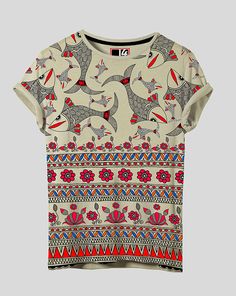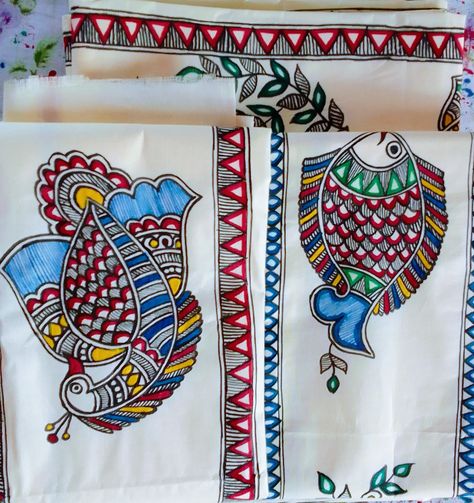Madhubani Saree Painting
Madhubani design, also known as Mithila painting, is a traditional art form originating from the Mithila region of Bihar, India. This unique style of painting is characterized by intricate patterns, vibrant colors, and themes that often depict nature, mythology, and everyday life. Madhubani art is not just a visual delight but also a cultural expression deeply rooted in the traditions and beliefs of the local communities.
Historical Background
Origins

Madhubani painting traces its origins back to ancient times, with references found in Hindu texts that suggest it was practiced even during the times of the Ramayana. Traditionally, these paintings were created by women on the walls of their homes, particularly during festivals and special occasions. The art form served both decorative and narrative purposes, often depicting scenes from mythology, nature, and social rituals.
Cultural Significance
Madhubani art reflects the rich cultural heritage of the Mithila region. It is not merely a craft but an integral part of the community’s identity. Each painting tells a story, embodying the beliefs, traditions, and values of the people. The art form has evolved over time, adapting to contemporary themes while retaining its traditional essence.
Characteristics of Madhubani Design
Techniques
Madhubani paintings are traditionally done using natural dyes and pigments. The techniques vary, but they generally involve the following:
- Brush Technique: Fine brushes made from twigs or hair are used to create intricate lines and patterns.
- Finger Painting: Some artists use their fingers to apply paint, resulting in unique textures.
- Stippling: Dots are used to fill in areas and add detail, creating depth and complexity.
Themes and Motifs
Madhubani art is rich in themes and motifs. Common subjects include:
- Nature: Plants, animals, and landscapes are frequently depicted, showcasing the beauty of the natural world.
- Mythology: Stories from Hindu mythology, especially those involving gods and goddesses, are central to many paintings.
- Social Life: Scenes depicting weddings, festivals, and daily activities are also prevalent, reflecting the cultural practices of the community.
Color Palette
The colors used in Madhubani painting are vibrant and bold. Traditionally, artists used natural materials to create pigments, such as:
- Vegetable Dyes: Extracts from plants like turmeric (yellow), indigo (blue), and madder (red) were commonly used.
- Mineral Colors: Earthy tones were derived from minerals to add depth to the artwork.
Today, synthetic colors are also used, but many artists prefer to stick to traditional methods.
Styles of Madhubani Painting
Madhubani painting is classified into different styles based on the techniques and themes employed. The primary styles include:
Bharni Style
This style is characterized by vibrant colors and intricate patterns. It typically features religious themes and is known for its bold outlines.
Kachni Style
Kachni paintings are monochromatic and focus on fine line work. This style often incorporates detailed motifs, creating a delicate and intricate effect.
Godhana Style

This style is associated with the depiction of animals and human figures, often used for storytelling. The designs are bold and colorful, capturing the essence of rural life.
Tantrik Style
Tantrik Madhubani art is deeply rooted in spiritual and mystical themes. It often includes intricate patterns and symbols that represent various deities and rituals.
The Process of Creating Madhubani Art
Preparation
Creating Madhubani art begins with preparing the canvas. Traditionally, artists use handmade paper or cloth. The surface is often treated with a mixture of cow dung and mud to create a textured backdrop.
Sketching
The next step involves sketching the outline of the design using a pencil or charcoal. This initial drawing serves as a guide for the detailed work that follows.
Painting
Once the sketch is complete, artists begin filling in the colors. They use fine brushes or their fingers to apply natural dyes, carefully following the outlines. The painting is built up in layers, allowing for depth and richness in the colors.
Detailing
After the initial colors are applied, artists add intricate details using fine brushes. This step involves stippling and creating patterns that enhance the overall composition.
Final Touches
Once the painting is complete, it may be framed or hung on walls. Some artists apply a protective layer to ensure the longevity of the artwork.
Contemporary Relevance
Revival and Popularity
In recent years, there has been a resurgence of interest in Madhubani art, both in India and internationally. Artists have begun to explore new themes, incorporating contemporary issues like environmental conservation and social justice into their works. This evolution has helped keep the tradition alive while making it relevant to modern audiences.
Commercialization
Madhubani art has found its way into various commercial products, including textiles, home decor, and stationery. This commercialization has provided artists with new avenues for income while increasing awareness of this traditional art form.
Education and Workshops
Workshops and educational programs focused on Madhubani art have emerged, allowing new generations to learn and appreciate this craft. These initiatives not only preserve the art form but also empower local communities by providing skills and income opportunities.

Conclusion
Madhubani design is more than just an art form; it is a reflection of culture, history, and community identity. Its intricate patterns, vibrant colors, and meaningful themes tell stories that resonate with people across generations. As Madhubani art continues to evolve and adapt to contemporary contexts, it remains a testament to the creativity and resilience of the artists who carry forward this rich tradition. By appreciating and supporting Madhubani art, we not only celebrate its beauty but also contribute to the preservation of an invaluable cultural heritage.
